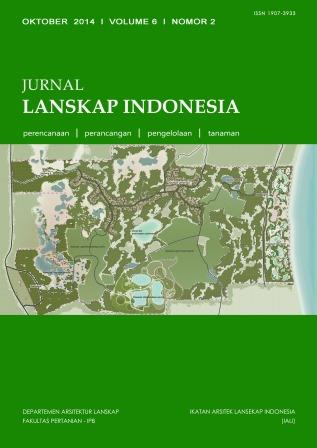EVALUASI JALUR HIJAU TEPI JALAN KAMPUS INSTITUT PERTANIAN BOGOR DARMAGA
Abstract
This is an evaluation of roadside greenery. This evaluation was held in five main road in IPB Darmaga Campus. The aim of this activity is to identify and assess the condition of roadside greenery in IPB Darmaga. This activity was conducted as one part of the series efforts to optimize the effectiveness of roadside greenery function. The evaluation results can be used as a material consideration in the development of streetscape further. Evaluate the condition of roadside greenery by considering five aspects, such as: (1) road type and position on the road, (2) landscape regulatory and road geometry, (3) characteristics and plant growth requirements, (4) the desired function of planting and (5) psychological effects that expected from planting . They are five aspects consideration in the street scape plants application, that has been formulated by Lestari (2005). The comparative method was used to measure suitability and compatibility roadside greenery in Kampus IPB Darmaga based on landscape regulations that contained in five aspects above. Based on them, the evaluation found an information that many planting design of roadside greenery in IPB Darmaga Campus is less accordance with the planting design guidelines and principles. This was caused by disruptions due to the planting design that is too diverse in plant species selection without an appropriate arrangement with the environment. Recommended solutions to overcome this problem is by creating a more organized and themed planting design. It is more supportive for realization of the desired planting function. Recommended theme in this case is a theme that support campus visual and activity. The embodiment of such planting brings the consequence of the reduction, replacement, or addition by a more suitable plants. This activity is not an easy thing to do, it needs consideration for make it optimal and sustainable.Downloads
References
Anonim.1996. Campus landscape Master Plan of University of California Riverside. http://pdc.ucr.edu/does2/toc.ucr.htm
Carpenter, P.L., D. Walker, O. Lanphear, 1975. Plant in the Landscape. W.H.Freeman and Co., San Fransisco. 418 hal.
Direktorat Jenderal Bina Marga. 1996. Tata Cara Perencanaan Teknik Lan-skap Jalan. Departemen PU. Jakar-ta. 53 hal.
Direktorat Jenderal Bina Marga. 2010. Pedoman Teknis Penanaman Pohon pada Sistem Jaringan Jalan. Depar-temen PU. Jakarta.
Hakim, R. 1987. Unsur Perancangan dalam Arsitektur Lanskap. Bina Aksara. Jakarta. 176 hlm.
Lestari. 2005. Evaluasi Kualitas Estetika Visual Pohon pada Lanskap Jalan. Skripsi. Jurusan Arsitektur Lan-skap. Fakultas Pertanian. Institut Pertanian Bogor. Bogor.
This journal permits and encourages authors to post items submitted to the journal on personal websites or institutional repositories both prior to and after publication, while providing bibliographic details that credit, if applicable, its publication in this journal. However, after the article is submitted and published in this journal, it is fully copyrighted by the Jurnal Lanskap Indonesia or JLI. If excerpts from other copyrighted works are included, the author must obtain written permission from the copyright owner and give credit to the source in the article. Then, the writer or reader is allowed to copy, share, and redistribute articles/material in any form. But it must still include the appropriate source and credit because the article in this journal is licensed by Creative Commons Attribution 4.0 International License (CC BY 4.0).
I. Proposed Policy for Journals That Offer Open Access
Authors who publish with this journal agree to the following terms:
- Authors retain copyright and grant the journal right of first publication with the work simultaneously licensed under a Creative Commons Attribution License that allows others to share the work with an acknowledgement of the work's authorship and initial publication in this journal.
- Authors are able to enter into separate, additional contractual arrangements for the non-exclusive distribution of the journal's published version of the work (e.g., post it to an institutional repository or publish it in a book), with an acknowledgement of its initial publication in this journal.
- Authors are permitted and encouraged to post their work online (e.g., in institutional repositories or on their website) prior to and during the submission process, as it can lead to productive exchanges, as well as earlier and greater citation of published work (See The Effect of Open Access).
II. Proposed Policy for Journals That Offer Delayed Open Access
Authors who publish with this journal agree to the following terms:
- Authors retain copyright and grant the journal right of first publication, with the work after publication simultaneously licensed under a Creative Commons Attribution License that allows others to share the work with an acknowledgement of the work's authorship and initial publication in this journal.
- Authors are able to enter into separate, additional contractual arrangements for the non-exclusive distribution of the journal's published version of the work (e.g., post it to an institutional repository or publish it in a book), with an acknowledgement of its initial publication in this journal.
- Authors are permitted and encouraged to post their work online (e.g., in institutional repositories or on their website) prior to and during the submission process, as it can lead to productive exchanges, as well as earlier and greater citation of published work (See The Effect of Open Access).



























